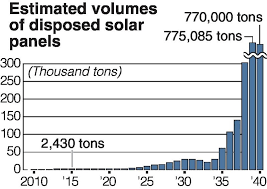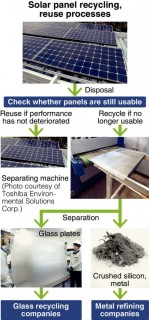Loading
Search
▼ Govt Seeks To Reduce Solar Panel Waste
- Category:Other
By Tatsuya Nozaki / Yomiuri Shimbun Staff Writer
With the rapid proliferation of solar panels, the Environment Ministry has released guidelines aimed at creating a system on the reuse or recycling of old ones.
Since the introduction of the Feed-in Tariff (FIT) system (see below) under which solar-generated electric power is purchased at fixed prices, solar panels have become more popular.
The ministry estimates that about 800,000 tons of solar panels will be scrapped when they expire in about 25 years. This is more than 200 times the volume of materials used to build Tokyo Tower.
Many aged solar panels are disposed of in landfills as industrial waste, and the ministry hopes to gain the cooperation of companies to reuse or recycle them instead.
At a plant of Toshiba Environmental Solutions Corp., a used solar panel was fed into a machine, and 10 minutes later a transparent glass plate about three millimeters thick was removed. The Yokohama-based company’s plant has been developing technologies for recycling solar panels since 2011.
A solar panel is made with thin sheets comprising silicon materials with electrodes attached to hard glass plates. The basic structure is then mounted on a frame made of aluminum and other materials. In the company’s plant, rotating brushes remove the silicon from the glass, without the use of chemicals or heating. The glass and other materials are then separated.
As the glass plates are undamaged during this process, the company is able to sell the plates to glass manufacturers. The silicon materials, which contain silver and other metals, are sent to metal refining companies for recycling.
“Solar panels should be environmentally friendly,” said an adviser to the company. “Disposing of them in landfills is meaningless.”
While he was speaking, he held pieces of solar panels after they had been processed. Each piece was five centimeters square.
An increasing number of solar panels are likely to be scrapped before their useful life expires, as more houses and other buildings are rebuilt with them installed. Therefore, reusing solar panel materials will become increasingly important.
With the rapid proliferation of solar panels, the Environment Ministry has released guidelines aimed at creating a system on the reuse or recycling of old ones.
Since the introduction of the Feed-in Tariff (FIT) system (see below) under which solar-generated electric power is purchased at fixed prices, solar panels have become more popular.
The ministry estimates that about 800,000 tons of solar panels will be scrapped when they expire in about 25 years. This is more than 200 times the volume of materials used to build Tokyo Tower.
Many aged solar panels are disposed of in landfills as industrial waste, and the ministry hopes to gain the cooperation of companies to reuse or recycle them instead.
At a plant of Toshiba Environmental Solutions Corp., a used solar panel was fed into a machine, and 10 minutes later a transparent glass plate about three millimeters thick was removed. The Yokohama-based company’s plant has been developing technologies for recycling solar panels since 2011.
A solar panel is made with thin sheets comprising silicon materials with electrodes attached to hard glass plates. The basic structure is then mounted on a frame made of aluminum and other materials. In the company’s plant, rotating brushes remove the silicon from the glass, without the use of chemicals or heating. The glass and other materials are then separated.
As the glass plates are undamaged during this process, the company is able to sell the plates to glass manufacturers. The silicon materials, which contain silver and other metals, are sent to metal refining companies for recycling.
“Solar panels should be environmentally friendly,” said an adviser to the company. “Disposing of them in landfills is meaningless.”
While he was speaking, he held pieces of solar panels after they had been processed. Each piece was five centimeters square.
An increasing number of solar panels are likely to be scrapped before their useful life expires, as more houses and other buildings are rebuilt with them installed. Therefore, reusing solar panel materials will become increasingly important.
Toshiba Environmental Solutions first checks whether the generation efficiency of the solar panels has deteriorated, and then determines if they should be reused as second-hand products or processed for recycling.
“In the future, when markets for second-hand solar panels and routes for recycling solar panels are established, we want to determine the best way to dispose of them,” the adviser said. Since July 2012, when the FIT system was introduced, solar panels have rapidly become more popular.
As of the end of fiscal 2014, the number of solar panels installed were capable of generating a combined output of more than 18 million kilowatts. This is equivalent to the output of 18 nuclear reactors.
But the efficiency of solar panels, which are considered to have a useful life of 20 to 30 years, declines with aging. In June last year, the ministry compiled a report about the proper disposal of solar power generation equipment.
About 2,400 tons of solar panels are scrapped as waste every year. If the life of solar panels is assumed to be 25 years, the volume of scrapped panels can be expected to rapidly increase around 2035. In 2040, the volume is estimated to rise to about 770,000 tons.
This is equivalent to 6 percent of the total volume of industrial waste disposed in landfill sites in this country in fiscal 2012.
“Unless recycling routes are established without delay, there will be a shortage of landfill sites when mega solar power plants are renewed,” a ministry official said. “The situation could become chaotic in some regions.”
The latest guidelines are meant to prepare for the huge volume of scrapped solar panels in the coming years. In the guidelines, the ministry addressed the concerns of several parties, such as companies with power-generation facilities that operate mega solar power plants; transportation service companies; and industrial waste-disposal companies.
For example, as solar panels generate electric power when they are exposed to sunlight, workers may receive electric shocks even after the panels have been removed from roofs and other places.
The ministry recommends that workers who remove solar panels and transportation workers cover the surfaces of solar panels with sheets to block sunlight.
It also recommends that workers wear insulated gloves and rubber boots, and use insulated tools, as well as avoid working on rainy and snowy days when the risk of electric shock becomes greater.
Solar panels contain such metals as lead, copper, silver and tin. Therefore, the ministry has provided guidelines to waste-disposal companies indicating that recycling is more profitable than disposing in landfill sites.
A ministry official said: “We have received an increasing number of inquiries from people in the recycling industry who see the situation as a business opportunity. By utilizing the guidelines, we hope to establish proper routes for disposal.”
■ Feed-in Tariff system
Launched in July 2012 with the aim of popularizing such renewable energy resources as solar power, wind power, geothermal power and biomass. Power companies are obliged to purchase electric power generated by renewable energy resources at fixed prices decided by the government for a designated length of time.
“In the future, when markets for second-hand solar panels and routes for recycling solar panels are established, we want to determine the best way to dispose of them,” the adviser said. Since July 2012, when the FIT system was introduced, solar panels have rapidly become more popular.
As of the end of fiscal 2014, the number of solar panels installed were capable of generating a combined output of more than 18 million kilowatts. This is equivalent to the output of 18 nuclear reactors.
But the efficiency of solar panels, which are considered to have a useful life of 20 to 30 years, declines with aging. In June last year, the ministry compiled a report about the proper disposal of solar power generation equipment.
About 2,400 tons of solar panels are scrapped as waste every year. If the life of solar panels is assumed to be 25 years, the volume of scrapped panels can be expected to rapidly increase around 2035. In 2040, the volume is estimated to rise to about 770,000 tons.
This is equivalent to 6 percent of the total volume of industrial waste disposed in landfill sites in this country in fiscal 2012.
“Unless recycling routes are established without delay, there will be a shortage of landfill sites when mega solar power plants are renewed,” a ministry official said. “The situation could become chaotic in some regions.”
The latest guidelines are meant to prepare for the huge volume of scrapped solar panels in the coming years. In the guidelines, the ministry addressed the concerns of several parties, such as companies with power-generation facilities that operate mega solar power plants; transportation service companies; and industrial waste-disposal companies.
For example, as solar panels generate electric power when they are exposed to sunlight, workers may receive electric shocks even after the panels have been removed from roofs and other places.
The ministry recommends that workers who remove solar panels and transportation workers cover the surfaces of solar panels with sheets to block sunlight.
It also recommends that workers wear insulated gloves and rubber boots, and use insulated tools, as well as avoid working on rainy and snowy days when the risk of electric shock becomes greater.
Solar panels contain such metals as lead, copper, silver and tin. Therefore, the ministry has provided guidelines to waste-disposal companies indicating that recycling is more profitable than disposing in landfill sites.
A ministry official said: “We have received an increasing number of inquiries from people in the recycling industry who see the situation as a business opportunity. By utilizing the guidelines, we hope to establish proper routes for disposal.”
■ Feed-in Tariff system
Launched in July 2012 with the aim of popularizing such renewable energy resources as solar power, wind power, geothermal power and biomass. Power companies are obliged to purchase electric power generated by renewable energy resources at fixed prices decided by the government for a designated length of time.
- June 18, 2016
- Comment (0)
- Trackback(0)



